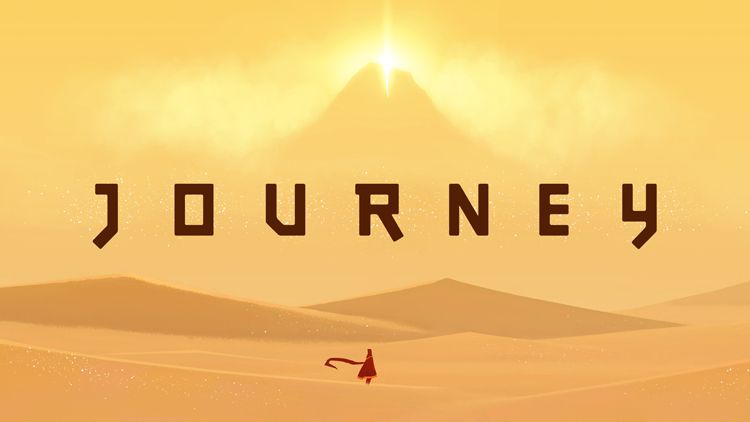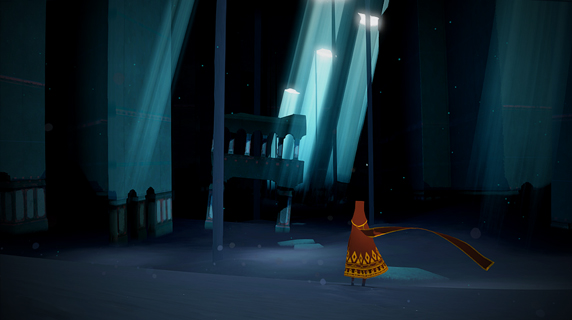It wasn't until the credits ceased to roll and a trophy reward sound clinked me back to reality, that I realized I had been crying. No, sobbing. Fat, quiet tears had flooded from my eyes, like the shifting sands of the game, completely drenched the controller clutched in my trembling fingers.
It was two in the morning, and I was slumped in a puddle of angst and awe on my couch after finishing thatgamecompany's latest creation, Journey.
Don't you dare try and tell me video games can't be forms of art. Fiction must be powerful to move your reality, and for a game to push the limits of its medium as to inspire deep reflection, even tears, is a feat of amazement. Journey is art, and quite possibly the perfect game.
When a game leaves your soul in shreds, you know the developers did something right. A broken mess, it took me a while to wrap my head around what had just happened. In a little under three hours I had completed Journey -- I had savored every last piece of scenery, every chiming "shout" and the beautiful sway of every piece of sentient cloth. I had ridden the wind and watched my little hooded figure twirl among tiny scattered monoliths -- gravestones -- watching its scarf stream like a banner of courage behind it. I couldn't tear my eyes away.
Journey begins with your character, a small pointy-footed figure in crimson robes, waking up in the swirling golden sands of the desert. Besides a few simple pictorial demonstrations of gameplay controls, there is no further instruction other than a strong hint that the player should move towards the light on top of a mysterious mountain. As your robed figure moves through the desert and stumbles through ruins, he will encounter floating pieces of cloth. These pieces of cloth empower the player, lighting up glyphs on the figure's scarf, allowing them to jump, bring nearby objects to life, and use a special mechanic called a "shout."
A "shout" will animate inanimate bolts of cloth, creating bridges and ladders of a sort for mobility through the environment. Collecting "shout" symbols and freeing trapped cloth in each area allows the hooded figure to view special visions and reveal murals on the surrounding architecture. The figure's scarf grows as it collects glyphs scattered about the desert, and each additional bolt of cloth adds power and length to the figure's jump and "shout."
That's about all there is to it. Tilting the controller or right analogue stick rotates the camera angle, and you can jump, shout, and move around. There are no more moves, no complicated functions. Gameplay is a quest to forge onward, using the environment in clever ways to shield your hooded figure from oppressive wind, among other things...
Journey is gorgeous, a stunning visual testament to how far we have come in producing game graphics. The game breaks the barrier between life and art, blurring the lines and forcing its players to ask themselves: How much of the decisions they make for their hooded figure are decisions they would make for themselves? How deeply you invest yourself in this game offers a self-reflection on the way you play games -- and on your own life.
Playing Journey is a journey in and of itself. What pieces of its story are the most powerful is dependent on the one holding the controller. What resonates is unique to each individual, and what the story is ultimately depends on him or her as well. Nothing is explicitly stated, and nothing is for certain. But everything, every fluttering cloth and shifting dune, is beautiful.
The entire game, designed to be playable in one sitting, will take you the better part of three hours. Those who measure a game's success by the amount of time it eats up and the dearth of content will not find what they are looking for. Those with open minds will find three unforgettable hours filled with gorgeously blended colors splashed across a rich environment evocative of plush technicolor landscapes one only encounters in dreams. Journey could very well be a dream, and you will feel that way as you slide down glittering gold sand dunes that move and flow like water.
The score is unlike any other video game soundtrack you will ever encounter, as it marries perfectly, seamlessly, with gameplay. Both emotion and action heighten simultaneously, drive to a spiralling climax by the wavering, simmering sound of chimes, drums, strings, and every other piece of magical wonder composer Austin Wintory has woven into Journey's tapestry. Simply put, it is a sensory overload that will surely explode your mind, or at least your heart. If you complete this game and are not moved in some way, I officially pronounce you dead.
I spent my entire first playthrough of Journey alone, isolated, feeling small and sad in a world too beautiful for my heart to bear. Upon my rebirth I set out again, resigned to the fact that I may go through this world alone yet again, that my fate may be to glide across the sands of time as a solitary figure, an individual lost in a sea of gold with only faith and fortitude to push me forward.
Then I found him. Or her. Or whoever they were. I slid down a dune and turned a corner into a sea of tombstone-like structures and there they were.
The most astounding, overwhelming feeling occurs in that moment when you find another figure. This figure -- my partner, my companion, my new friend -- must have seen me simultaneously, because in the next second our little pointed feet were flying as we hastened to each other. The first thing that happened when they were close enough for me to see their face was beautiful: they shouted. At me. They shouted at me. My heart almost burst I was so moved -- moved by this stranger's unabashed joy -- or so it felt, in the context of the game -- to see me.
Journey's co-op plunks players down into the world at random without any sort of communication whatsoever. No names are exchanged, and you both look identical. You can't say anything -- in fact, there is no need to. Chances are you are both feeling the same thing, the same pang of wonder and heartbreak at how beautiful and nearly empty the world is. Keeping close to each other recharges the glyphs on your scarves. I served as my companion's leader, guiding them to hidden "shout" glyphs and twirling happily when they unfroze another bolt of cloth. This particular strain of multiplayer felt completely natural -- we had no objectives, no hints, no real direction other than forward, up, and towards the mountain. Our cooperation was pure, our teamwork real and true. Rather than pressing switches and pulling each other along, we drifted wordlessly side by side, chiming as we solved puzzles, collected cloth, and unlocked murals along the way.
I have never felt more connection to another player in a co-op mode before. While the nature of touching, unlocking, collecting cloth is fairly impersonal, as is the need to touch each other to relight your scarves, the core of the game's true nature is what heightens the sense of companionship, the sense that while you can (or already have) completed the journey on your own, you need the other player. Once you have found them, to say you don't need them is to embrace abandonment and welcome utter loneliness. When they leave, as is inevitable with every run through Journey, the loss of their presence will weigh heavy. Desolation will replace the sense of silent camaraderie, and you will once more return to absorbing the delicate, achingly beautiful world of Journey alone.
With design, mechanics, and meanings as subtle as its name, Journey crosses the boundary between games and art; I'm not even sure you can call it a video game. The allure is in every step you take, every grain of sand and shaft of light you turn your eyes to. It is a world you cannot stop yourself from immersing in. I could wax on and on about what this game means, what you will feel, what will snatch your breath out of your throat and stop your heart cold...but that is something you must, and can only, experience for yourself. This is the kind of game that is best walked into at least half-blind, a pilgrimage best absorbed through complete and total sensory immersion. Everything works together and blends to construct the perfect bridge between games and art, the ultimate sensory experience.
This. Just, this.
Journey
- Released
- March 13, 2012
- Developer(s)
- Thatgamecompany
- Publisher(s)
- Sony
- Genre(s)
- Adventure
- Engine
- PhyreEngine
- ESRB
- E For Everyone due to Mild Fantasy, Violence
- How Long To Beat
- 2 Hours



